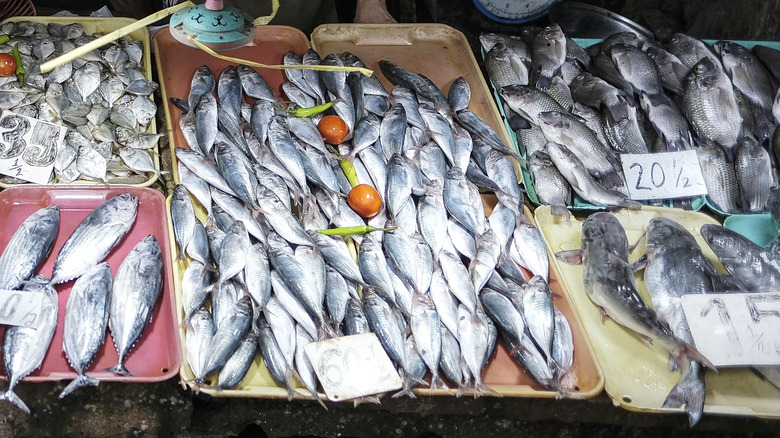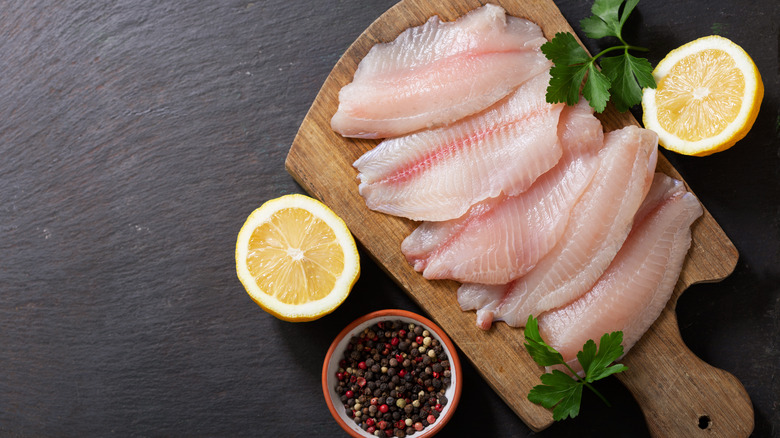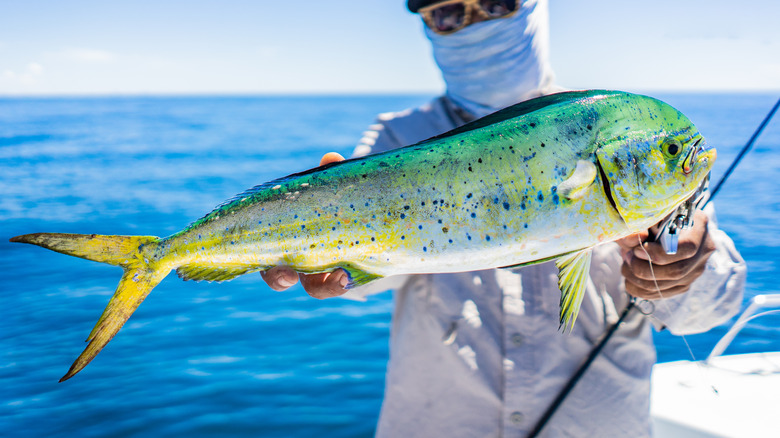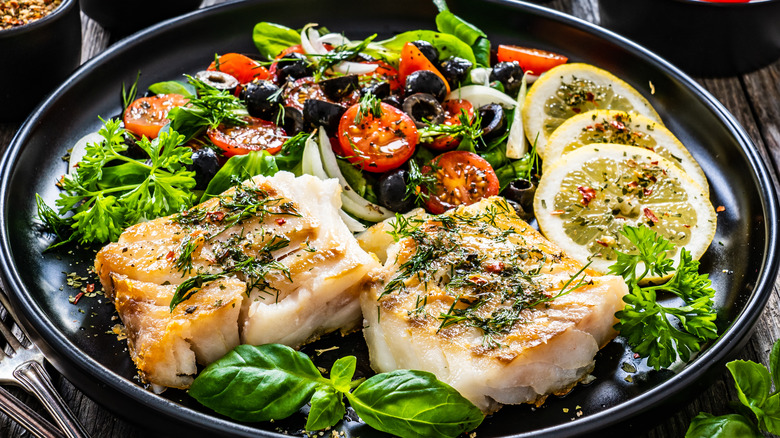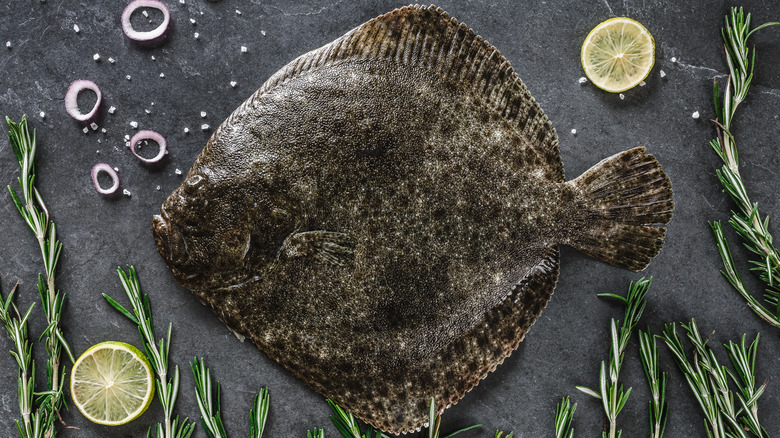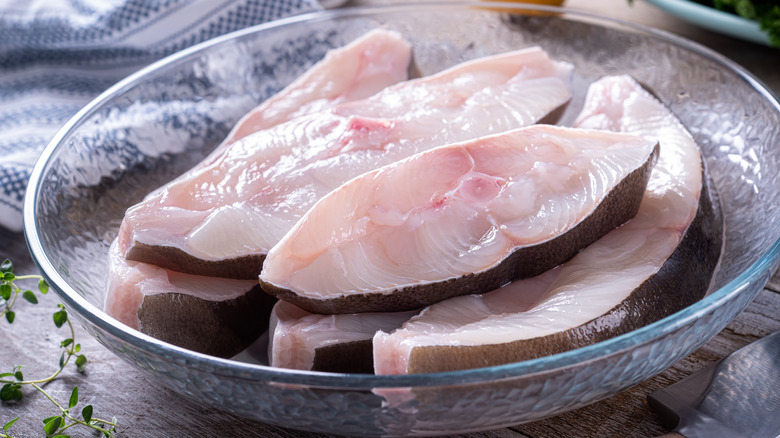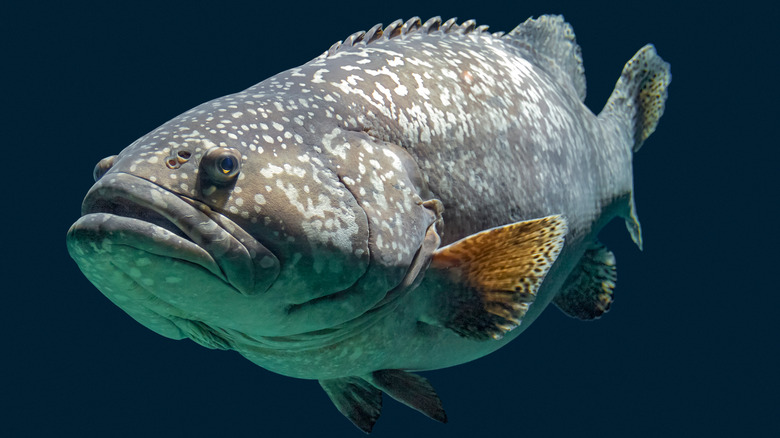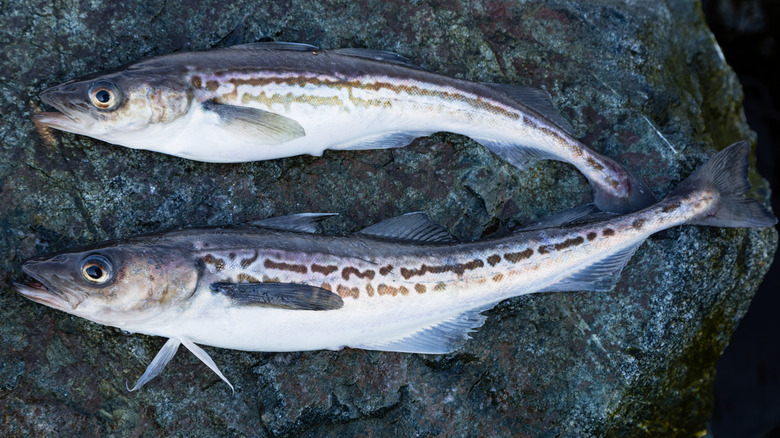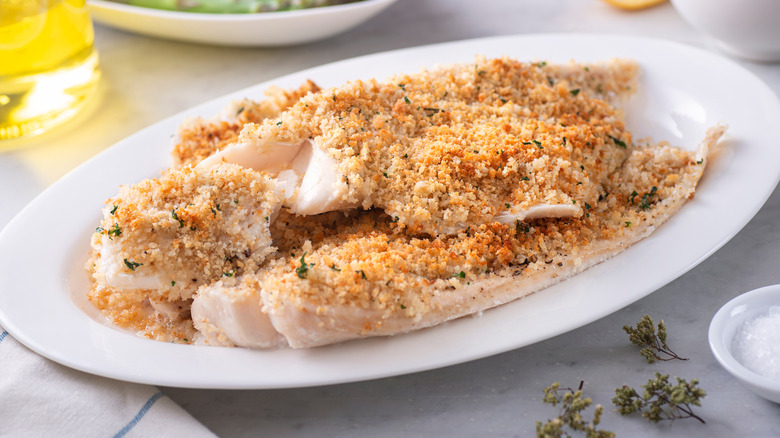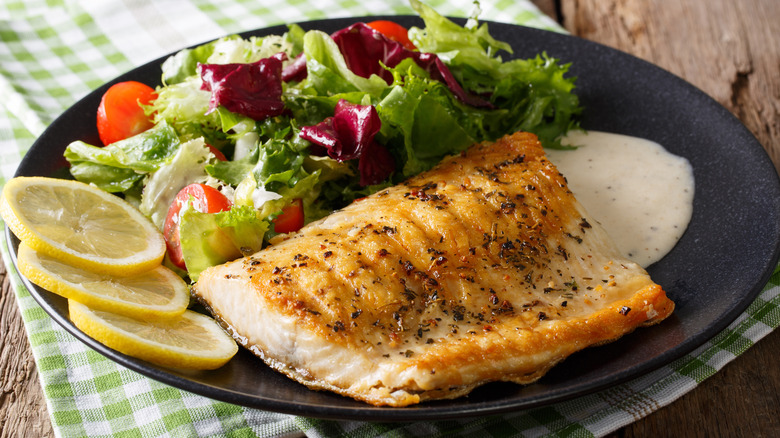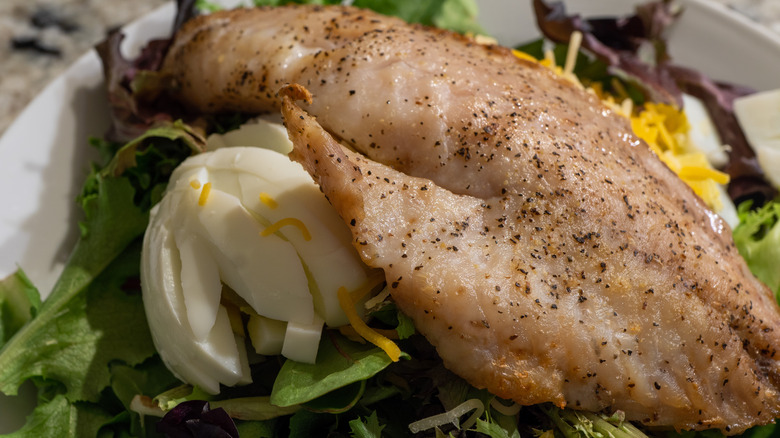Fish For People Who Don't Like Fish
When Teddy Roosevelt said that "nothing in the world is ... worth doing unless it means effort," he may as well have been talking about maintaining your physical health. After all, is there anyone out there who thinks the two main ways we can influence our overall health — eating properly and exercising consistently — are effortless?
Clearly, the monumental benefits found from those two activities makes them worth doing. Yet just as very few things play a bigger hand in your physical well-being than exercise and nutrition, very few things are as difficult to do consistently as working out and eating right. So if you're eager to reap the health benefits from something you're not exactly excited about ... say, jogging or eating fish ... how can you do so without torturing yourself in the process?
Well, if the sheer thought of eating fish makes you queasy, fret no longer! Not unlike the various exercise options available for people who hate running, there are ways to obtain the undeniable health benefits found from ingesting seafood — even if you can't stand the taste, smell, or texture commonly-associated with fish.
It may surprise you, but there are actually numerous species of fish that don't taste very fishy. Let's take a look at the best available non-fishy tasting fish on the market, and ways you can increase your seafood intake without making yourself miserable.
Tilapia
If your personal palate abhors the flavor of fish, one of the best varieties at your disposal is tilapia. Despite the bizarre rumors in recent years surrounding the fish — including the one that claimed tilapia is somehow worse for you than bacon — this mild-flavored fish is just as nutritionally beneficial as most other seafood.
The very lean, high-protein species is a substantial source of omega-3 fatty acids, despite its low fat content, and has a mild, almost sweet taste (via The Healthy Fish) that's amenable to whatever flavors you choose to add to it. Since tilapia is already only mildly fishy to start with, the addition of spices and herbs can help reduce the fishy flavor and smell even further (via AllWomen'sTalk).
Tilapia is fairly simple to prepare, and is the type of fish that "doesn't fall apart" when cooked, according to recipe developer, Susan Olayinka. While the flavor of the fish may vary between farm-raised and wild-caught tilapia, either variety will provide a nutritionally-dense option — with a flavor that's tailor-made for people who don't like fish.
Mahi mahi
A favorite target for sportfishing enthusiasts, mahi mahi's distinctive shape and color — with its skin speckled in an eye-popping swirl of green, blue, and yellow — makes it one of the most stunning ocean-dwelling species. And with a mild-yet-distinctive flavor, combined with a slightly firm texture, mahi mahi is one of the best options available for people who don't like fish.
Similar to many other white fish species, mahi mahi is low in fat and high in protein, which according to a Quora response by Vinayak Durve, retired professor of limnology and fisheries at Rajasthan Agricultural University, helps reduce the inherent fishy flavor, as the oil and fat level of a fish is largely responsible for how fishy it tastes. Given its texture and generally-mild flavor, mahi mahi is commonly compared to other not-very-fishy-tasting species, such as swordfish and halibut.
Additionally, mahi mahi filets are sturdy, and don't become flaky while cooking, retaining a meaty texture once prepared. The texture of mahi mahi means it's perfectly suited for grilling, whether you're using a standard grill grate, or a slab of slate like world-renowned chef, Eric Ripert.
Cod
While it may no longer be very prevalent around its namesake vacation spot, Cape Cod (via NPR), cod remains one of the best available seafood options for people who dislike fish. Like many other white fish species, cod has a very mild taste making it decidedly unfishy.
The lack of overall flavor makes cod a great way to increase your seafood intake. Not only is it loaded with nutritional benefits as a low-fat, high-protein option, but the almost-absent taste of cod makes it ideal for introducing any sort of flavor you desire.
Cod filets are often deep-fried, given its slightly firm texture that becomes flaky when cooked, and are one of the standard fish choices for fish and chips. Of course, while deep frying any fish will increase the deliciousness, it also inevitably tips the scales away from it being a healthy option.
If you're hoping to reap the nutritional benefits enjoyed when eating fish, consider skipping the batter and fryer when preparing it, and opt for a baked option, like this recipe for Mediterranean baked cod.
Swordfish
The long, sword-like broadbill that distinguishes the swordfish — and gives the fish its name — may be its defining characteristic. But with a firm, meaty texture that's akin to beef (via Tastylicious), the swordfish should also be known as a go-to fish option for people who dislike fish, but still want to eat it.
Frankly, no other species may top swordfish as a potential non-fishy tasting option. Though not a white fish, swordfish has a similarly mild taste that's quite susceptible to the addition of external flavors. And with its surprisingly firm texture, swordfish makes the transition to eating fish simple and familiar for non-fish lovers.
The substantially firm texture of swordfish makes it highly-suitable for grilling, given it will remain intact while cooking over the flame. Not only that, but grilling (rather than frying) swordfish ensures its nutritional value remains intact, as it does in this recipe for grilled swordfish.
Flounder
If you find the concept of eating flounder morally-objectionable because you can't imagine a world where you'd eat Flounder from "The Little Mermaid"? Well, rest easy, folks, because Ariel's brightly-colored best pal wasn't a flounder at all — meaning this mild-tasting white fish is another fantastic option for the non-fish eater to add seafood to their diet.
Flounder's lack of robust flavor makes it strongly suited to the palate of those who prefer land-based proteins. Like many similar white fish, flounder is slightly sweet with a very low fat content (via Tastylicious). Its incredibly delicate and flaky texture can make it difficult to cook, and baking may be the best method of preparation as a result.
Flounder can be a nutritional dynamo given its overall makeup as a high-protein species. But, like any other fish, not all cooking techniques are created equal, and certain styles may diminish its nutritious element. For instance, though the sight and smell of Popeyes' flounder sandwich may convert even the staunchest non-fish fan, it won't benefit your health to consume the battered and fried fish.
Halibut
Another white fish with a mild flavor, halibut makes for an excellent initial foray into the world of seafood for people who don't like fish. The adaptable taste of the world's largest flatfish (via Taste of Home) will help the transition for those who can't stand the smell or taste of fish, and its firm texture may remind newcomers of more familiar meats, like beef or poultry.
If you're aiming to reduce the fish smell and flavor of halibut even more, try soaking it in milk for 20 minutes before cooking (via Cook's Illustrated). The protein in milk binds to the chemical that causes the distinctively nasty fish odor (trimethylamine oxide), resulting in an even less-fishy product than before.
When you consider the nutritional profile of this low-fat, high-protein fish, finding ways to incorporate it into your diet — and finding ways to make it less fishy — will only lead to positive results. Just make sure you follow the advice of renowned "Iron Chef," Alex Guarnaschelli, and remove the skin before cooking.
Grouper
Another mild-tasting variety of white fish (are you sensing a pattern here?), grouper is a great option for people who are looking for a less fishy flavor. While grouper has fairly high levels of oil compared to other white fish (via Tastylicious), it doesn't taste overly fishy, and is prone to take on whatever flavors you prefer to highlight.
Beyond its mild taste and inherent sweetness, grouper has a firm-yet-flaky texture once it's cooked, and becomes almost velvety when eaten. And while the higher oil level doesn't increase the grouper's fishy flavor, as you would expect it to, it does help keep the fish from drying out during the cooking process, ensuring it remains moist and flavorful once prepared.
Grouper's higher oil content always means it's suited for a wide variety of cooking methods, as there's less chance of ruining it by overcooking. But similar to other mild white fish, the best way to prepare grouper may be to bake it or pan-sear it, as in this recipe for grouper with parsnip puree from chef, Jeremiah Bacon.
Alaska pollock
Can you tell the difference between Alaska pollock, cod, and haddock? Probably not! Though this related white fish species does have a slightly higher oil and fat content than the other two traditional fish and chips options — a result of its extremely cold habitat — Alaska pollock is still a similarly mild-tasting variety, just like its closely related cousins.
A high-protein option that's chock full of omega-3 fatty acids (via Epicurious), Alaska pollock is known to have a slightly firm texture, making it an excellent choice for people who aren't a fan of fish's expected textural makeup (via Samuels Seafood). Since Alaska pollock filets tend to firm up when cooked, they can also be prepared in a variety of ways, while maintaining their taste and nutrition.
And eating Alaska pollock isn't just good for your health; it's good for the environment, too. According to the National Oceanic and Atmospheric Administration, Alaska pollock is both "sustainably managed and responsibly harvested," making it an excellent choice for your waistline — and your conscience.
Haddock
With a flavor profile often described as almost-identical to cod, haddock is another mild-tasting white fish with very low fat and oil levels — and, therefore, a less fishy taste overall, according to Tastylicious. Haddock is so similar to cod, in fact, that they're often used interchangeably by chefs, though its firmer texture does help differentiate it from its close cousin.
A fish that recipe developer and food photographer, Jennine Bryant, calls "meaty and flaky ... with a subtle, sweet flavor," haddock may indeed be indistinguishable from cod in its deep-fried form. This is why it, like cod, is used so often in fish and chips.
However, if you're someone who dislikes fish, but you want to add it to your diet for health reasons, eating fried fish of any variety isn't the way to go. To ensure you get the most out of haddock, both nutrition and taste-wise, you should try baking it (if whole), or pan-searing filets for a crispy skin (via Great British Chefs).
Arctic char
It may surprise some of you to see arctic char on this list, given its close relation to salmon (a fish very few people would describe as unfishy). But while there are indeed similarities between the two fish, arctic char is less oily than salmon, which helps reduce the naturally fishy flavor that turns many people off (via Tastylicious).
Arctic char — which renowned chef and "Chopped" judge, Marcus Samuelsson, called "one of my favorite types of fish" (via Forbes) — does have a higher fat content than other fish on this list. But, similar to grouper, this doesn't make it taste more fishy; it simply allows the fish to retain moisture during the cooking process, making it a strong choice for any method of preparation (via Fortune Fish & Gourmet).
Additionally, arctic char filets have a firm, meaty texture, providing an appealing mouthfeel for first-time fish eaters. And since its higher oil and fat content provides a wide variety of cooking options, you can even find ways to prepare a hearty arctic char dish that remains healthy.
Rockfish
Though some may know this species of fish as "rock cod" or "Pacific snapper" (via Wild Alaskan Company), rockfish is simply another variety of mild-tasting white fish. Like many other fish on this list, rockfish has a lower oil and fat content, and its generally-lacking natural flavor makes it an exemplary seafood option for anyone eager to eat fish that doesn't taste like fish.
Rockfish is superbly malleable to the introduction of external flavors, and is well-suited for a multitude of marinades, particularly those that complement its slightly-nutty taste. But rockfish isn't just easily amenable to the injection of other flavors — it's also capable of withstanding a number of different cooking methods, making it one of the simplest fish species to prepare (via Wild Alaskan Company).
From baking, to grilling, to pan-searing, there are no shortage of cooking options that can deliver an astonishingly tasty meal with rockfish. In addition to its adaptability and nutrient-dense profile, rockfish are known to be one of the longest-living vertebrates in the world, and often live for more than 100 years. In other words, what better species to help you live a long, healthy life than one with an average lifespan significantly longer than humans?
Lingcod
Despite the name, lingcod is not a part of the cod family at all, though its flavor profile is quite comparable to its fellow white fish. Another mild-tasting species that is perfect for imposing flavor (is there an echo in here?), the taste of lingcod is so mild that it's barely noticeable — meaning you can further ameliorate any potentially off-putting fish taste once prepared.
Beyond the fact that lingcod's lack of flavor makes it a wonderful choice for the non-fish fan, it's also phenomenal due to its status as a sustainable seafood. According to the Environmental Defense Fund, the implementation of a "catch share" management plan has drastically decreased overfishing of lingcod, and surrounding species, as of 2022.
Not only is there once again a robust population of lingcod to be harvested, but recent regulations even helped reduce bycatch (or the unintentional catching of fish, mammals, or other items not targeted by fishermen) by a whopping 75%. This makes lingcod the perfect fish option for people who don't like fish, as well as folks who hope to limit their personal impact on the environment.
